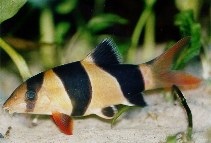Chromobotia macracanthus (Bleeker, 1852)
Clown loach
Upload your photos and videos
Pictures | Stamps, coins, misc. | Google imageChromobotia macracanthus
Picture by Dikic, D.
Pictures | Stamps, coins, misc. | Google imageChromobotia macracanthus
Picture by Dikic, D.
Indonesia country information
Common names:
Entebering, Ikan macan, Ulang uli
Occurrence: endemic
Salinity: freshwater
Abundance: fairly common (chances are about 50%) | Ref:
Importance: minor commercial | Ref:
Aquaculture: | Ref:
Regulations: restricted | Ref:
Uses: live export: yes;
Comments: Known from Sumatra and Borneo. Found in the Kapuas Lakes area in Kalimantan Barat, Borneo (Ref. 56749). Recorded from Danau Sentarum National Park in the Kapuas basin, Kalimantan Barat, Borneo (Ref. 56749). Exported in large quantities for the ornamental trade. Individuals larger than 15 cm cannot be exported (Ref. 12217), in an effort to safeguard the breeding stock (Ref. 13274). Also Ref. 26580.
National Checklist:
Country Information: https://www.cia.gov/library/publications/resources/the-world-factbook/geos/id.html
National Fisheries Authority:
Occurrences: Occurrences Point map
Main Ref: Kottelat, M., A.J. Whitten, S.N. Kartikasari and S. Wirjoatmodjo, 1993
National Database:
Occurrence: endemic
Salinity: freshwater
Abundance: fairly common (chances are about 50%) | Ref:
Importance: minor commercial | Ref:
Aquaculture: | Ref:
Regulations: restricted | Ref:
Uses: live export: yes;
Comments: Known from Sumatra and Borneo. Found in the Kapuas Lakes area in Kalimantan Barat, Borneo (Ref. 56749). Recorded from Danau Sentarum National Park in the Kapuas basin, Kalimantan Barat, Borneo (Ref. 56749). Exported in large quantities for the ornamental trade. Individuals larger than 15 cm cannot be exported (Ref. 12217), in an effort to safeguard the breeding stock (Ref. 13274). Also Ref. 26580.
National Checklist:
Country Information: https://www.cia.gov/library/publications/resources/the-world-factbook/geos/id.html
National Fisheries Authority:
Occurrences: Occurrences Point map
Main Ref: Kottelat, M., A.J. Whitten, S.N. Kartikasari and S. Wirjoatmodjo, 1993
National Database:
Common names from other countries
Classification / Names Common names | Synonyms | Catalog of Fishes(genus, species) | ITIS | CoL | WoRMS | Cloffa
Teleostei (teleosts) > Cypriniformes (Carps) > Botiidae (Pointface loaches) > Botiinae
More on author: Bleeker.
More on author: Bleeker.
Environment: milieu / climate zone / depth range / distribution range Ecology
Freshwater; demersal; pH range: 5.0 - 8.0; dH range: 5 - 12. Tropical; 25°C - 30°C (Ref. 1672); 5°N - 5°S
Distribution Countries | FAO areas | Ecosystems | Occurrences | Point map | Introductions | Faunafri
Asia: Endemic to Indonesia (Sumatra and Borneo).
Length at first maturity / Size / Weight / Age
Maturity: Lm ?, range 20 - ? cm
Max length : 30.5 cm TL male/unsexed; (Ref. 92922); max. published weight: 469.00 g (Ref. 92922)
Max length : 30.5 cm TL male/unsexed; (Ref. 92922); max. published weight: 469.00 g (Ref. 92922)
Short description Identification keys | Morphology | Morphometrics
Body orange with 3 black bars. Eyes not covered with skin (Ref. 13274).
Adults are found mostly at the bottom of main river channels, often hiding under rocks, woods, or in mud cavities (Ref. 92922). Juveniles are often found in the floodplains (Ref. 92922). Adults feed on worms, crustaceans and plant matter (Ref. 7020). Aquarium keeping: aggressive; in groups of 5 or more individuals; minimum aquarium size 150 cm (Ref. 51539).
Life cycle and mating behavior Maturity | Reproduction | Spawning | Eggs | Fecundity | Larvae
Breeding occurs at the beginning of the rainy season in fast flowing rivers (Ref. 1672).
Main reference
Upload your references | References | Coordinator | Collaborators
Kottelat, M., 2004. Botia kubotai, a new species of loach (Teleostei: Cobitidae) from the Ataran River basin (Myanmar), with comments on botiine nomenclature and diagnosis of a new genus. Zootaxa 401:1-18. (Ref. 50472)
IUCN Red List Status (Ref. 130435: Version 2024-2)
Least Concern (LC) ; Date assessed: 28 November 2019
Threat to humans
Harmless
Human uses
Fisheries: minor commercial; aquarium: highly commercial
FAO(Fisheries: production; publication : search) | FishSource |
More information
Population dynamics
Growth parameters
Max. ages / sizes
Length-weight rel.
Length-length rel.
Length-frequencies
Mass conversion
Recruitment
Abundance
Growth parameters
Max. ages / sizes
Length-weight rel.
Length-length rel.
Length-frequencies
Mass conversion
Recruitment
Abundance
Life cycle
Reproduction
Maturity
Fecundity
Spawning
Spawning aggregations
Eggs
Egg development
Larvae
Larval dynamics
Reproduction
Maturity
Fecundity
Spawning
Spawning aggregations
Eggs
Egg development
Larvae
Larval dynamics
Anatomy
Gill area
Brain
Otolith
Gill area
Brain
Otolith
Physiology
Body composition
Nutrients
Oxygen consumption
Swimming type
Swimming speed
Visual pigments
Fish sound
Diseases & Parasites
Toxicity (LC50s)
Body composition
Nutrients
Oxygen consumption
Swimming type
Swimming speed
Visual pigments
Fish sound
Diseases & Parasites
Toxicity (LC50s)
Tools
Bio-Quiz | E-book | Field guide | Length-frequency wizard | Life-history tool | Point map | Classification Tree
| Catch-MSY |
Special reports
Download XML
Internet sources
Alien/Invasive Species database | Aquatic Commons | BHL | Cloffa | BOLDSystems | Websites from users | Check FishWatcher | CISTI | Catalog of Fishes(genus, species) | DiscoverLife | ECOTOX | Faunafri | Fishtrace | GenBank(genome, nucleotide) | GloBI | GOBASE | | Google Books | Google Scholar | Google | IGFA World Record | MitoFish | Otolith Atlas of Taiwan Fishes | Public aquariums | PubMed | Reef Life Survey | Scirus | SeaLifeBase | Tree of Life | Wikipedia(Go, Search) | World Records Freshwater Fishing | Zoological Record
Estimates based on models
Phylogenetic diversity index (Ref. 82804): PD50 = 1.0000 [Uniqueness, from 0.5 = low to 2.0 = high].
Bayesian length-weight: a=0.01047 (0.00458 - 0.02392), b=2.97 (2.78 - 3.16), in cm Total Length, based on LWR estimates for this (Sub)family-body shape (Ref. 93245).
Trophic level (Ref. 69278): 2.9 ±0.32 se; based on food items.
Fishing Vulnerability (Ref. 59153): Low vulnerability (21 of 100).




